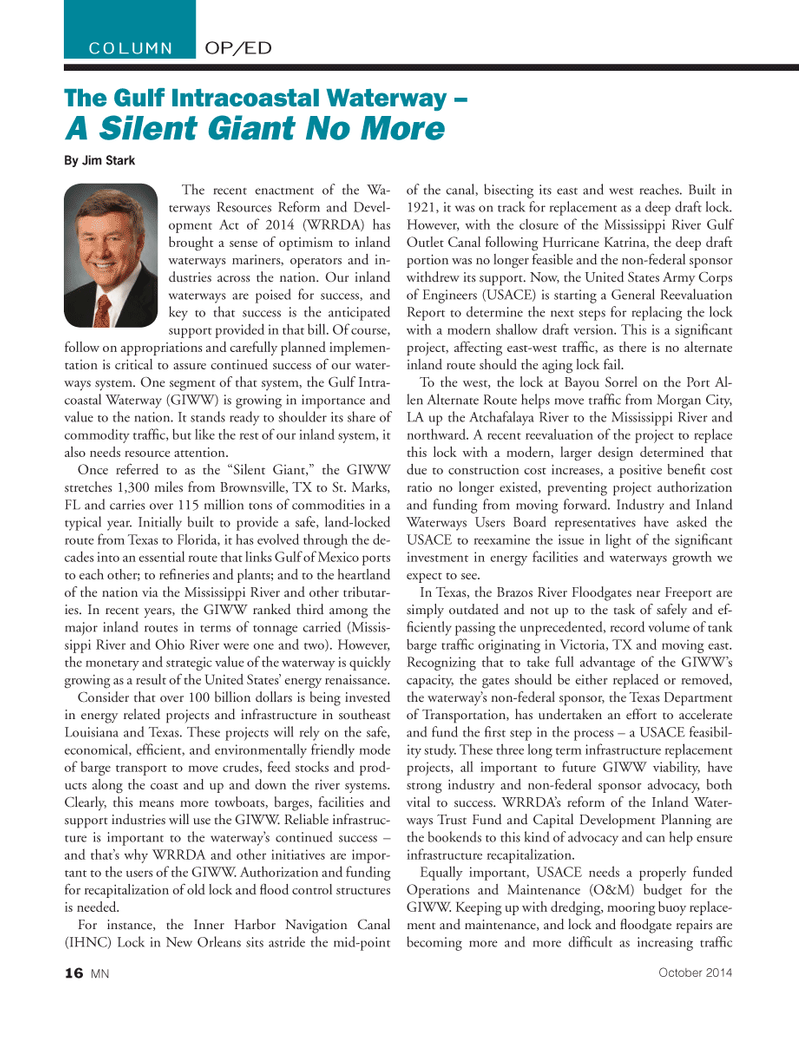
Page 16: of Marine News Magazine (October 2014)
Innovative Products & Boats - 2014
Read this page in Pdf, Flash or Html5 edition of October 2014 Marine News Magazine
The recent enactment of the Wa- terways Resources Reform and Devel- opment Act of 2014 (WRRDA) has brought a sense of optimism to inland waterways mariners, operators and in- dustries across the nation. Our inland waterways are poised for success, and key to that success is the anticipated support provided in that bill. Of course, follow on appropriations and carefully planned implemen- tation is critical to assure continued success of our water- ways system. One segment of that system, the Gulf Intra- coastal Waterway (GIWW) is growing in importance and value to the nation. It stands ready to shoulder its share of commodity traffi c, but like the rest of our inland system, it also needs resource attention.
Once referred to as the “Silent Giant,” the GIWW stretches 1,300 miles from Brownsville, TX to St. Marks,
FL and carries over 115 million tons of commodities in a typical year. Initially built to provide a safe, land-locked route from Texas to Florida, it has evolved through the de- cades into an essential route that links Gulf of Mexico ports to each other; to refi neries and plants; and to the heartland of the nation via the Mississippi River and other tributar- ies. In recent years, the GIWW ranked third among the major inland routes in terms of tonnage carried (Missis- sippi River and Ohio River were one and two). However, the monetary and strategic value of the waterway is quickly growing as a result of the United States’ energy renaissance.
Consider that over 100 billion dollars is being invested in energy related projects and infrastructure in southeast
Louisiana and Texas. These projects will rely on the safe, economical, effi cient, and environmentally friendly mode of barge transport to move crudes, feed stocks and prod- ucts along the coast and up and down the river systems.
Clearly, this means more towboats, barges, facilities and support industries will use the GIWW. Reliable infrastruc- ture is important to the waterway’s continued success – and that’s why WRRDA and other initiatives are impor- tant to the users of the GIWW. Authorization and funding for recapitalization of old lock and fl ood control structures is needed.
For instance, the Inner Harbor Navigation Canal (IHNC) Lock in New Orleans sits astride the mid-point of the canal, bisecting its east and west reaches. Built in 1921, it was on track for replacement as a deep draft lock.
However, with the closure of the Mississippi River Gulf
Outlet Canal following Hurricane Katrina, the deep draft portion was no longer feasible and the non-federal sponsor withdrew its support. Now, the United States Army Corps of Engineers (USACE) is starting a General Reevaluation
Report to determine the next steps for replacing the lock with a modern shallow draft version. This is a signifi cant project, affecting east-west traffi c, as there is no alternate inland route should the aging lock fail.
To the west, the lock at Bayou Sorrel on the Port Al- len Alternate Route helps move traffi c from Morgan City,
LA up the Atchafalaya River to the Mississippi River and northward. A recent reevaluation of the project to replace this lock with a modern, larger design determined that due to construction cost increases, a positive benefi t cost ratio no longer existed, preventing project authorization and funding from moving forward. Industry and Inland
Waterways Users Board representatives have asked the
USACE to reexamine the issue in light of the signifi cant investment in energy facilities and waterways growth we expect to see.
In Texas, the Brazos River Floodgates near Freeport are simply outdated and not up to the task of safely and ef- fi ciently passing the unprecedented, record volume of tank barge traffi c originating in Victoria, TX and moving east.
Recognizing that to take full advantage of the GIWW’s capacity, the gates should be either replaced or removed, the waterway’s non-federal sponsor, the Texas Department of Transportation, has undertaken an effort to accelerate and fund the fi rst step in the process – a USACE feasibil- ity study. These three long term infrastructure replacement projects, all important to future GIWW viability, have strong industry and non-federal sponsor advocacy, both vital to success. WRRDA’s reform of the Inland Water- ways Trust Fund and Capital Development Planning are the bookends to this kind of advocacy and can help ensure infrastructure recapitalization.
Equally important, USACE needs a properly funded
Operations and Maintenance (O&M) budget for the
GIWW. Keeping up with dredging, mooring buoy replace- ment and maintenance, and lock and fl oodgate repairs are becoming more and more diffi cult as increasing traffi c
OP/EDCOLUMN
The Gulf Intracoastal Waterway –
A Silent Giant No More
By Jim Stark
October 2014 16 MN
MN Oct14 Layout 1-17.indd 16 9/18/2014 3:25:20 PM

 15
15

 17
17
